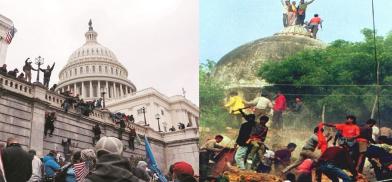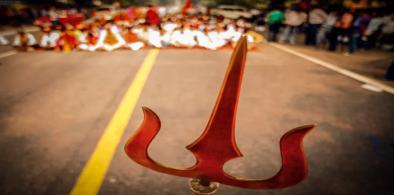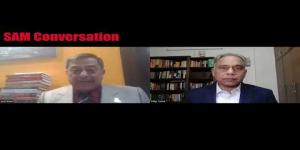Black days: January 6, 2021 in the US, December 6, 1992 in India
It is clear, therefore, that the politics of polarization which divides the citizens of a country - whether in the US, India or countries in Europe - between nationalists and anti-nationals is here to stay, writes Amulya Ganguli for South Asia Monitor

Some of the uncanny similarities between the mob attack on the Capitol building in Washington D.C. on January 6, 2021, and on the Babri Masjid in Ayodhya on December 6, 1992, are obvious.
For one, both were the handiwork of right-wing extremists. For another, they gathered in large numbers not by chance, but were instigated to do so by their political bosses.
The similarities
While the US President Donald Trump called for a “big protest in D.C. on January 6,” adding in his tweet, “be there, will be wild,” the BJP’s Uma Bharati reportedly told the assembled mob which had climbed on to the mosque, “ek dhakka aur do, Babri Masjid torh do” (Give one more push, destroy the Babri masjid).
As in Washington D.C., the saffron vandals had also gathered in Ayodhya in response to calls by Bharatiya Janata Party (BJP) leaders L.K. Advani and Murli Manohar Joshi, who had set out for Ayodhya to join them from Varanasi and Mathura, two towns whose mosques were – and still are - in the Hindu fanatics' crosshairs for destruction.
Moreover, while Trump is said to have watched with delight his supporters running amok, there is a photograph of Uma Bharati and Murli Monohar Joshi beaming as they watched the 500-year-old mosque being pulled down.
There are other similarities. For instance, the targeting of the Capitol building has been described as an attack on American democracy while the destruction of a protected monument has been seen as an attack on India’s secular ethos and historical heritage with leading newspapers describing December 6, 1992, as a day of shame.
Forgive-and-forget attitude
Notwithstanding the worldwide criticism which Trump has faced (except from China and Russia) and the likelihood of impeachment at home, a sizeable sections of the Republican Party are expected to turn a blind eye to his role in the January 6 “insurrection,” as the Democrats dub the events of that day.
The reason for their forgive-and-forget attitude is that the hooligans mainly comprised Trump’s and the Republican Party’s core supporters of white supremacists, although there was an Indian among them as well waving the national tricolour.
It was the same in the aftermath of the Babri Masjid’s demolition. Although the BJP initially appeared apologetic with Advani naming December 6 as the saddest day of his life – not so much for the destruction of the mosque as because of the breakdown of discipline among the saffron cadres – the party has subsequently appeared less and less remorseful about what happened on that fateful afternoon with its fellow-travellers like the Vishwa Hindu Parishad even observing December 6 as shaurya diwas or a day of valour.
The analogies remain relevant with respect to suspected conspiracies behind the two incidents. While the judiciary has acquitted Advani, Joshi and others from such accusations, there are reports that the US police believes that the attack on the Capitol building was well-planned.
Nor have the curtains been rung down on the brand of politics which has led to such egregious acts, as the Indian Supreme Court called the Babri Masjid demolition. Instead, the white supremacists in the US and the Hindu supremacists in India believe that they have done nothing wrong and that their claims to be true patriots are fully justifiable.
While the Republican Party has lost the recent presidential election along with their control over the two chambers of the Congress, the Hindu right is riding high in India. Facing no real political challenge, they expect to remain as the dominant force in the foreseeable future and implement their own version of a patriotic nation.
Politics of polarization
It is clear, therefore, that the politics of polarization which divides the citizens of a country - whether in the US, India or countries in Europe - between nationalists and anti-nationals is here to stay. When it began in the US and India a few years ago, it was seen as an aberration which will either face electoral rejection or fade out as the right-wing leaders realize that large and diverse countries cannot be run on sectarian lines.
But neither has happened. Since large sections of the electorate continue to subscribe to the divisive ideologies – in the US, India and several European countries – the right-wing parties have been able to hold their own in the electoral field and their leaders have realized that their toxic policies – in the eyes of their opponents – are a paying proposition.
The essence of these policies includes primal elements like colour, xenophobia and religious prejudice. They have always existed, vide, the denial of human rights to the blacks whose last example was apartheid in South Africa, the religious wars in Europe between the Catholics and Protestants in medieval times and the persecution of Jews in Nazi Germany in the 20th century.
But it was hoped that the modern age will put an end to such crude impulses which Indian rulers like Asoka (273-232 B.C.) and Akbar (1556-1605) shunned during their reigns and whose ideals are now enshrined in the Indian constitution.
But the venomous proclivities have survived among sections of the people to be cynically exploited by unscrupulous politicians.
(The writer is a commentator on current affairs. The views are personal)










Post a Comment